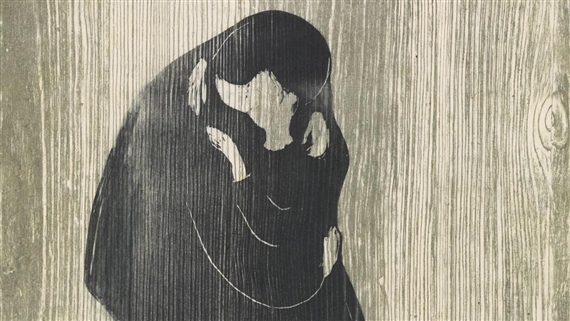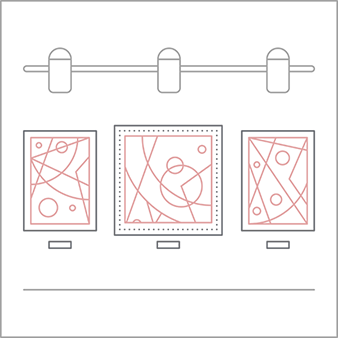Impressions. Five centuries of woodcuts
This exhibition will showcase the woodcut and its many functions and stylistic possibilities.
With varying degrees of popularity, the age-old woodcut technique has been in use since the sixteenth century, and there seems recently to be a renewed interest in this art form. Is there a connection between todayÔÇÖs digitized visual media and the woodcuts of yore?
A good answer here is mass communication. Five centuries ago, words and images were disseminated to the common people through woodcuts. Although this is perhaps far removed from todayÔÇÖs digital modes of reproduction, the democratic idea of widely reproducing and distributing images has remained at the core.
Wood structure, lines, and colour
The exhibition, which is primarily based on the museumÔÇÖs own holdings, focuses on the functions and stylistic possibilities allowed by the woodcut. The thematic division indicates above all how both material and technique have influenced the artistsÔÇÖ visual styles.
We see how artists such as Edvard Munch and Paul Gauguin used the wood blockÔÇÖs structure and growth ring pattern as an aesthetical element in their woodcuts. We also show the tremendous variation in the use of lines and surfaces, from Albrecht D├╝rerÔÇÖs thin, meticulous linework to Emil NoldeÔÇÖs rougher and more angular forms.
Another theme in the exhibition is the techniqueÔÇÖs inherent possibilities when it comes to the use of colour, as can be seen in the sophisticated nineteenth-century Japanese woodcuts and later on in works by Nikolai Astrup and Hanne Borchgrevink.
Woodcut as a process
The German artist Thomas Kilpper works with large-scale woodcuts from a socially critical perspective. The exhibition will dedicate an entire room to his work, where he will use the floor to create woodcuts and thereafter mount the prints as a three-dimensional installation in the room.
The exhibition will also feature a group of students from the Oslo National Academy of the Arts working on a woodcut project as an ongoing, collective process. During certain periods they will be present in one of the rooms to show visitors how they work with the medium.

Recommended for you
This exhibition will showcase the woodcut and its many functions and stylistic possibilities.
With varying degrees of popularity, the age-old woodcut technique has been in use since the sixteenth century, and there seems recently to be a renewed interest in this art form. Is there a connection between todayÔÇÖs digitized visual media and the woodcuts of yore?
A good answer here is mass communication. Five centuries ago, words and images were disseminated to the common people through woodcuts. Although this is perhaps far removed from todayÔÇÖs digital modes of reproduction, the democratic idea of widely reproducing and distributing images has remained at the core.
Wood structure, lines, and colour
The exhibition, which is primarily based on the museumÔÇÖs own holdings, focuses on the functions and stylistic possibilities allowed by the woodcut. The thematic division indicates above all how both material and technique have influenced the artistsÔÇÖ visual styles.
We see how artists such as Edvard Munch and Paul Gauguin used the wood blockÔÇÖs structure and growth ring pattern as an aesthetical element in their woodcuts. We also show the tremendous variation in the use of lines and surfaces, from Albrecht D├╝rerÔÇÖs thin, meticulous linework to Emil NoldeÔÇÖs rougher and more angular forms.
Another theme in the exhibition is the techniqueÔÇÖs inherent possibilities when it comes to the use of colour, as can be seen in the sophisticated nineteenth-century Japanese woodcuts and later on in works by Nikolai Astrup and Hanne Borchgrevink.
Woodcut as a process
The German artist Thomas Kilpper works with large-scale woodcuts from a socially critical perspective. The exhibition will dedicate an entire room to his work, where he will use the floor to create woodcuts and thereafter mount the prints as a three-dimensional installation in the room.
The exhibition will also feature a group of students from the Oslo National Academy of the Arts working on a woodcut project as an ongoing, collective process. During certain periods they will be present in one of the rooms to show visitors how they work with the medium.
Artists on show
- A.K. Dolven
- Albrecht Dürer
- Anna-Eva Bergman
- Anne Kampmann
- Annette Kierulf
- Asger Jorn
- Berit Arnestad
- Caroline Kierulf
- Edvard Munch
- Einar Lasse Kolsrud
- Eli Hovdenak
- Elin Rødseth
- Emil Nolde
- Erich Heckel
- Erik Harry Johannessen
- Erik Werenskiold
- Ernst Barlach
- Ernst Ludwig Kirchner
- Eystein Sigurdsson
- Félix Vallotton
- Georg Baselitz
- Gunhild Vegge
- Gunnar S. Gundersen
- Guttorm Guttormsgaard
- Hanne Borchgrevink
- Harald Kihle
- Iver Iversen Jåks
- Jan Henning Larsen
- Jenny Røed Vard
- Johannes Borchgrevink Hansen
- Johannes Rian
- Karin Mamma Andersson
- Karl Erik Nilsen
- Karl Munch
- Karl Schmidt-Rottluff
- Katsushika Hokusai
- Kitagawa Utamaro
- Knut Rumohr
- Ludvig Eikaas
- Ludvig Peter Karsten
- Magne Furuholmen
- Marianne Boberg
- Marianne Bratteli
- Marthe Karen Kampen
- Mattias Harenstam
- Michael Wolgemut
- Niclas Gulbrandsen
- Nikolai Astrup
- Ola Jonsrud
- Ørnulf Ranheimsaeter
- Paul Gauguin
- Per Kirkeby
- Ragnhild Løkke
- Shunkōsai Hokushu
- Sonja Krohn
- Ståle Blaesterdalen
- Tachibana Morikuni
- Tal R
- Thomas Kilpper
- Thorbjørn Egner
- Tom Gundersen
- Tore Hansen
- Torii Kiyonaga
- Totoya Hokkei
- Trine Lindheim
- Ugo Da Carpi
- Ulla Wennberg
- Utagawa Hiroshige
- Utagawa Kunisada
- Vilhelm Tveteraas
- Zinnia Gjengstø

 ARTISTS
ARTISTS













